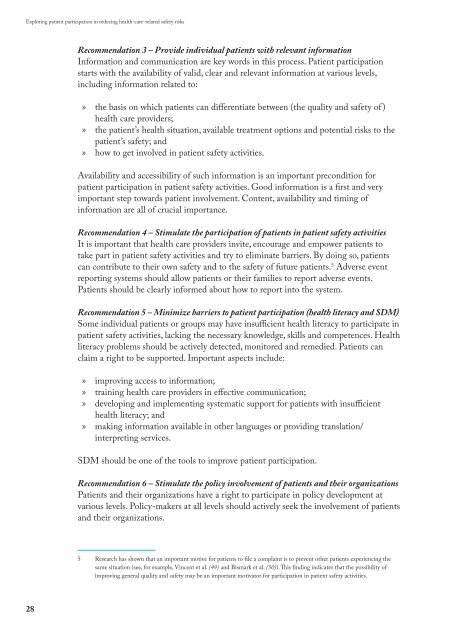Exploring patient participation in reducing health-care-related safety risks
Exploring patient participation in reducing health-care-related safety risks
Exploring patient participation in reducing health-care-related safety risks
Create successful ePaper yourself
Turn your PDF publications into a flip-book with our unique Google optimized e-Paper software.
<strong>Explor<strong>in</strong>g</strong> <strong>patient</strong> <strong>participation</strong> <strong>in</strong> reduc<strong>in</strong>g <strong>health</strong>-<strong>care</strong>-<strong>related</strong> <strong>safety</strong> <strong>risks</strong><br />
28<br />
Recommendation 3 – Provide <strong>in</strong>dividual <strong>patient</strong>s with relevant <strong>in</strong>formation<br />
Information and communication are key words <strong>in</strong> this process. Patient <strong>participation</strong><br />
starts with the availability of valid, clear and relevant <strong>in</strong>formation at various levels,<br />
<strong>in</strong>clud<strong>in</strong>g <strong>in</strong>formation <strong>related</strong> to:<br />
» the basis on which <strong>patient</strong>s can differentiate between (the quality and <strong>safety</strong> of )<br />
<strong>health</strong> <strong>care</strong> providers;<br />
» the <strong>patient</strong>’s <strong>health</strong> situation, available treatment options and potential <strong>risks</strong> to the<br />
<strong>patient</strong>’s <strong>safety</strong>; and<br />
» how to get <strong>in</strong>volved <strong>in</strong> <strong>patient</strong> <strong>safety</strong> activities.<br />
Availability and accessibility of such <strong>in</strong>formation is an important precondition for<br />
<strong>patient</strong> <strong>participation</strong> <strong>in</strong> <strong>patient</strong> <strong>safety</strong> activities. Good <strong>in</strong>formation is a first and very<br />
important step towards <strong>patient</strong> <strong>in</strong>volvement. Content, availability and tim<strong>in</strong>g of<br />
<strong>in</strong>formation are all of crucial importance.<br />
Recommendation 4 – Stimulate the <strong>participation</strong> of <strong>patient</strong>s <strong>in</strong> <strong>patient</strong> <strong>safety</strong> activities<br />
It is important that <strong>health</strong> <strong>care</strong> providers <strong>in</strong>vite, encourage and empower <strong>patient</strong>s to<br />
take part <strong>in</strong> <strong>patient</strong> <strong>safety</strong> activities and try to elim<strong>in</strong>ate barriers. By do<strong>in</strong>g so, <strong>patient</strong>s<br />
can contribute to their own <strong>safety</strong> and to the <strong>safety</strong> of future <strong>patient</strong>s. 5 Adverse event<br />
report<strong>in</strong>g systems should allow <strong>patient</strong>s or their families to report adverse events.<br />
Patients should be clearly <strong>in</strong>formed about how to report <strong>in</strong>to the system.<br />
Recommendation 5 – M<strong>in</strong>imize barriers to <strong>patient</strong> <strong>participation</strong> (<strong>health</strong> literacy and SDM)<br />
Some <strong>in</strong>dividual <strong>patient</strong>s or groups may have <strong>in</strong>sufficient <strong>health</strong> literacy to participate <strong>in</strong><br />
<strong>patient</strong> <strong>safety</strong> activities, lack<strong>in</strong>g the necessary knowledge, skills and competences. Health<br />
literacy problems should be actively detected, monitored and remedied. Patients can<br />
claim a right to be supported. Important aspects <strong>in</strong>clude:<br />
» improv<strong>in</strong>g access to <strong>in</strong>formation;<br />
» tra<strong>in</strong><strong>in</strong>g <strong>health</strong> <strong>care</strong> providers <strong>in</strong> effective communication;<br />
» develop<strong>in</strong>g and implement<strong>in</strong>g systematic support for <strong>patient</strong>s with <strong>in</strong>sufficient<br />
<strong>health</strong> literacy; and<br />
» mak<strong>in</strong>g <strong>in</strong>formation available <strong>in</strong> other languages or provid<strong>in</strong>g translation/<br />
<strong>in</strong>terpret<strong>in</strong>g services.<br />
SDM should be one of the tools to improve <strong>patient</strong> <strong>participation</strong>.<br />
Recommendation 6 – Stimulate the policy <strong>in</strong>volvement of <strong>patient</strong>s and their organizations<br />
Patients and their organizations have a right to participate <strong>in</strong> policy development at<br />
various levels. Policy-makers at all levels should actively seek the <strong>in</strong>volvement of <strong>patient</strong>s<br />
and their organizations.<br />
5 Research has shown that an important motive for <strong>patient</strong>s to file a compla<strong>in</strong>t is to prevent other <strong>patient</strong>s experienc<strong>in</strong>g the<br />
same situation (see, for example, V<strong>in</strong>cent et al. (49) and Bismark et al. (50)). This f<strong>in</strong>d<strong>in</strong>g <strong>in</strong>dicates that the possibility of<br />
improv<strong>in</strong>g general quality and <strong>safety</strong> may be an important motivator for <strong>participation</strong> <strong>in</strong> <strong>patient</strong> <strong>safety</strong> activities.



